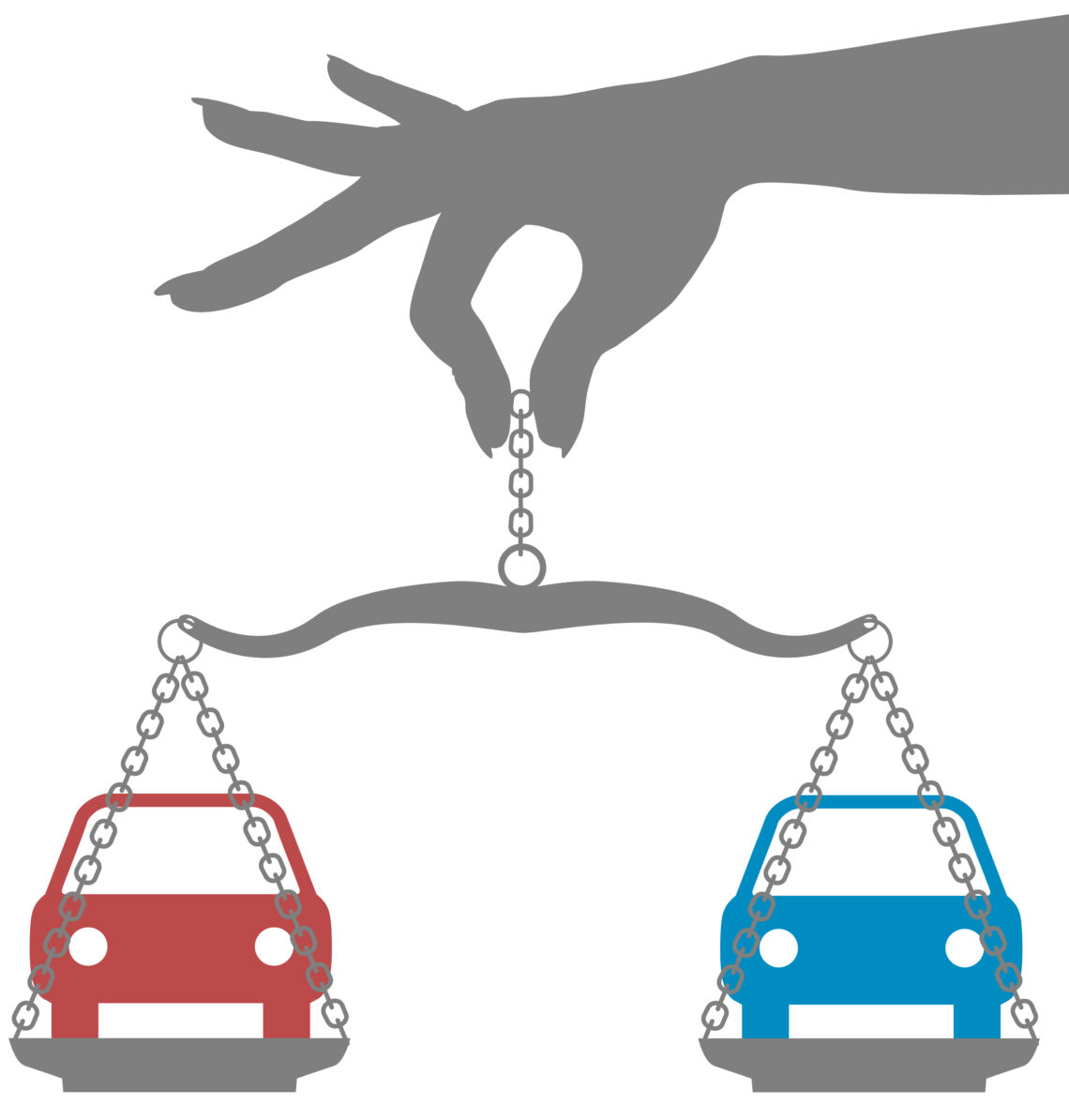Starting is always the hardest part, isn’t it? The blank page, the first date, which social network to begin your research on before that first date. It’s always a challenge to begin something. Selecting your next car is certainly one of them, as many of us don’t love any one particular brand or model. However, just like with that compatibility research when it comes to finding a new car, it helps to start by comparing two of the popular ones.
Kia and Hyundai offer some of the top cars, SUVs, and electric vehicles (EVs) on the market. The brands share many similarities since Hyundai Motor Group is the parent company of both automakers. But despite their commonalities, these two siblings have distinct personalities and vehicle lineups. Explore the similarities and differences between comparable Kia and Hyundai vehicles and consider the pros and cons of Kia vs. Hyundai vehicle models to help you decide which is best for you.
Kia Telluride vs. Hyundai Palisade
When you need a larger SUV for your growing family, it’s worth looking at the Kia Telluride and the Hyundai Palisade. The Kia Telluride sports a rugged exterior, while the Hyundai Palisade features a bold, refined appearance. Both SUVs offer three rows of seats for up to eight people. The Telluride comes standard with synthetic leather seats, while the base Palisade features cloth upholstery. Both models offer premium interior details, like heated and leather-trimmed seats, as you move up in trims.
The same engine powers both the Kia Telluride and the Hyundai Palisade. The 3.8-liter V-6 engine produces 291 horsepower and 262 pound-feet of torque. Front-wheel drive is standard and all-wheel drive is optional, but some Telluride trims only come with all-wheel drive. Both SUVs can tow up to 5,000 pounds, although the top-level Telluride can handle an additional 500 pounds.
The Kia Telluride and the Hyundai Palisade have advanced safety features like rear occupant alert, safe exit assist, and driver attention warning. Each vehicle also has dozens of driver-assistance features, including blind-spot collision warning, lane-keeping assist, and forward collision warning.
Overall, the Kia Telluride and the Hyundai Palisade have more similarities than differences. The base Telluride feels slightly more luxurious with the leatherette seating, but otherwise, the base trims offer similar space, performance, and functionality. Consider an upper-level Kia Telluride if you want an SUV with all-wheel drive or increased towing capacity.
Hyundai Tucson vs. Kia Sportage
The Hyundai Tucson and the Kia Sportage are compact SUVs that command attention on the road. The Tucson has a sporty exterior with angular lines, while the Sportage has a broad stance and muscular frame. Both SUVs ride on 17-inch alloy wheels, offering LED headlights and daytime running lights. The Sportage also features LED taillights in the back.
You’ll find standard cloth seats inside either SUV with 60/40 split-folding rear seats. Most Kia Sportage trims come with a 10-way power-adjustable driver’s seat, while nearly every Hyundai Tucson has an eight-way power driver’s seat. Step up from the base trim to get dual-zone automatic climate control in the Kia Sportage, a feature only available as part of a package in the comparable Tucson trim.
Both SUVs have a 2.5-liter four-cylinder engine, delivering 187 horsepower and 178 pound-feet of torque. Front-wheel drive comes standard, and all-wheel drive is optional. The Hyundai Tucson and the Kia Sportage achieve the same EPA-estimated fuel ratings, but both come in hybrid and plug-in hybrid versions if you want increased efficiency.
The Tucson and the Sportage each carry the latest technology features. Both have a standard 8-inch infotainment touchscreen, but upper Sportage trims have a 12.3-inch screen, compared with a 10.25-inch system in higher-level Tucson models. Both SUVs offer Apple CarPlay and Android Auto capability, but wireless integration is only available in the Tucson.
With numerous similarities between the two SUVs, the choice may come down to your personal preferences. The Hyundai Tucson has a sharper appearance compared to the Kia Sportage’s curved lines. Inside, you may prefer the larger touch screen in some Sportage models, or you may want to ditch the cords for wireless smartphone integration in the Tucson.
Kia EV6 vs. Hyundai IONIQ 5
The all-electric Kia EV6 and Hyundai IONIQ 5 are ideal choices if you’re looking for an electric vehicle with optimal efficiency. The Kia EV6 makes a bold statement with its athletic frame, while the IONIQ 5 comes in a slightly more subtle, sophisticated package. Both EVs have standard 19-inch wheels, LED headlights, and rear spoilers. The EV6 comes with rain-sensing windshield wipers and a smart power liftgate, features that aren’t standard in the IONIQ 5.
Both SUVs have a technology-focused interior, with 12.3-inch dual panoramic displays. Navigation, smartphone integration, and front and rear USB ports come standard in both EVs. Wireless charging comes standard in the EV6 but not in the IONIQ 5. Inside the EV6, vegan leather covers the seats, while the IONIQ 5 features standard cloth upholstery. A leather-wrapped steering wheel, eight-way power-adjustable driver’s seat, and heated front seats come standard in both vehicles.
The electric powertrain in both SUVs features a single electric motor paired with a battery. All-wheel-drive versions have dual motors and larger batteries. The rear-wheel-drive EV6 can achieve up to 310 miles of electric range, while all-wheel-drive versions get up to 282 miles. The IONIQ 5 has a 303-mile driving range in rear-wheel-drive versions and a 266-mile range in the all-wheel-drive models. With DC fast charging, the battery in both SUVs can recharge from 10% to 80% in about 18 minutes.
Although both EVs offer top-of-the-line features, you’ll get more standard amenities in the Kia EV6, like rain-sensing windshield wipers, wireless charging, and leather seating. Both provide similar driving ranges and efficiency, making them good options for an all-electric vehicle.
Kia Sorento vs. Hyundai Santa Fe
For a mid-sized SUV that’s anything but middle-of-the-road, consider either the Kia Sorento or the Hyundai Santa Fe. The sporty Sorento rides on 17-inch wheels, and the refined Santa Fe delivers slightly larger 18-inch wheels. Both SUVs have LED headlights, but only the Santa Fe comes standard with LED daytime running lights.
Both SUVs come standard with cloth seats and offer leather-trimmed seats in upper trims. Besides the base trims, both vehicles have heated front seats and power-adjustable driver’s seats. An 8-inch touchscreen comes standard in both SUVs, but you can get a larger 10.25-inch screen if you move beyond the base models.
The Sorento and Santa Fe each have the same 2.5-liter four-cylinder engine, generating 191 horsepower and 181 pound-feet of torque. In the upper trims of both SUVs, a turbocharged engine produces an additional 281 horsepower and 311 pound-feet of torque. Fuel economy ratings are nearly identical for both front-wheel and all-wheel-drive models.
The passenger capacity is the most significant difference between the Kia Sorento and the Hyundai Santa Fe. The Sorento has three rows of seats for up to seven passengers, while the Santa Fe has two-row seating for five. Still, passengers may feel cramped in the Sorento’s third row, which only offers 29.6 inches of legroom. With all rear seats folded down, you’ll get slightly more cargo space in the Sorento. The Kia Sorento provides a maximum of 75.5 cubic feet of cargo volume, compared with 72.1 cubic feet in the Hyundai Santa Fe.
The Kia Sorento’s third-row seating may appeal to families requiring the extra passenger space. If you don’t need three rows of seats, the Hyundai Santa Fe offers additional desirable features, including larger wheels and LED daytime running lights.
Kia vs. Hyundai: Pros and cons
Across their lineups, Kia and Hyundai vehicles share powertrains and features. Both brands also offer incredible value for their vehicles’ price, quality, and reliability.
Kia vehicles generally have sportier exteriors and athletic frames to accentuate the brand’s perky persona. Kia also offers lower starting prices for more of its cars, and it tends to equip even base models with more interior features than Hyundai. Kia has a reputation for building energetic vehicles that are fun to drive.
In contrast, Hyundai models feature conventional styling, ideal for people who prefer the traditional look and feel of sedans and SUVs. Hyundai vehicles are also known for their smooth rides, impressive fuel efficiency, and long-term reliability. You may choose Hyundai if you’re looking for a comfortable, spacious vehicle for your family.
Summary of Kia vs. Hyundai
Overall, Kia and Hyundai share many similarities but are separate brands with different offerings for various drivers. With different trims and options, both brands make it easy to find the right car for you. When comparing the two manufacturers, research their comparable vehicles to find the one that best matches your lifestyle and budget.
If you’re not ready to purchase either a Kia or a Hyundai, why not consider a vehicle subscription? At Flexcar, we know car ownership can be intimidating for some. That’s why we offer an easy, no-hassle subscription service, allowing you to drive the car you want for as long as you want. Visit our website for more details and preview the vehicles you can order in your area.





